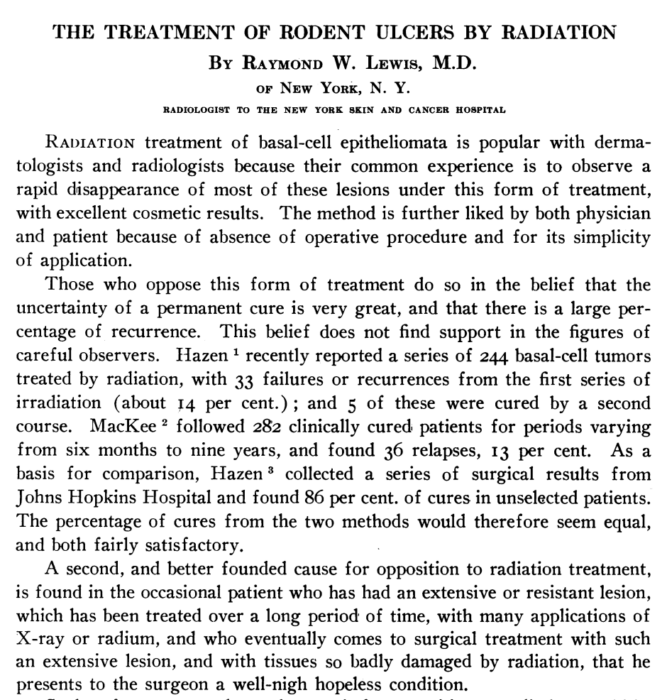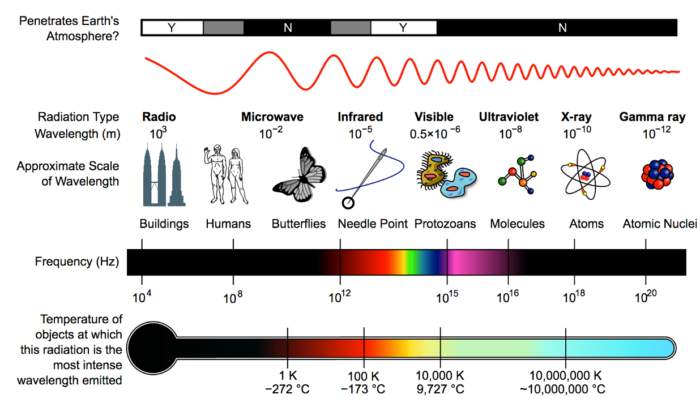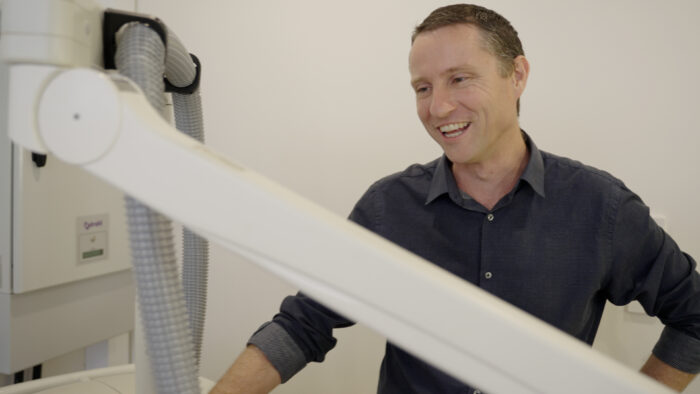Radiation Works
Not long after the discovery of X rays by William Röntgen in 1895, X rays were used to treat cancer. In the illustrated publication,(1) radiation was used to treat malignant growth successfully.

Built on more than 100 years of experience, modern radiation remains a cornerstone treatment in eradicating cancer. The role of radiation in treating skin cancers is undisputed (2,3) and offers results on par with surgery in contemporary publications.
Radiation is not mysterious
Radiation is part of the electromagnetic spectrum (4) and in the broadest sense can be considered as light therapy. As the wavelength of radiation decreases and the frequencies increase the radiation transitions from long waves and radio waves to infra-red l light, visible light, ultraviolet light and eventually X-rays.

https://en.wikipedia.org/wiki/Electromagnetic_spectrum
The X rays have sufficiently small wavelengths to interact on atomic level and if these rays have sufficient energy they are termed ionizing radiation. This means that they can eject electrons from the orbitals of atoms, (in the Böhr atomic model), and these free electrons go on to cause the required DNA damage in cancer.
The radiation effect depends on the energy of the radiation beam.
When radiation interacts with tissue it interacts with the tissue and this interaction is
dependent on many factors but in particular the energy of the radiation beam. One of the
ways to illustrate this effect is a percentage depth dose curve. The graph illustrates the
difference between low energy 100kV beam and megavoltage radiation (5).

http://www naweb.iaea.org/nahu/dmrp/documents/slides/chapter_07_treatment_planning.pdf
The 100kV beam has 100% of the dose on the skin surface and this drops down to less than 10% at 5 cm. In contrast in the 8MV beam there is still 80% of the dose at 5 cm. It makes sense to treat skin cancer with superficial radiation (SXRT) rather than megavoltage radiation in that the dose is applied to the skin and drops off very quickly. It is a good reason not to treat skin with VMAT, megavoltage radiotherapy. We use beam energies of 50-80 kV , which are less penetrating than 100kV beams and they are even more skin specific.
Electron beams are unique in that they react with tissue very extensively and lose all their energy within a defined range. They are ideal in managing skin cancers but there is no perfect electron application in skin and the best option remains superficial radiotherapy.
The treatment effect depends on the total radiation dose and number of fractions.
Radiation dose is measured in Gray. One Gray (Gy) is the international system of units (SI) equivalent of 100 rads, which is equal to an absorbed dose of 1 Joule/kilogram of tissue.
When radiation is given in a number of steps (fractions) there is time for biological repair and recovery in tissue and the concept of dose and fractionation are essential to understand radiation effects. In modern practice microscopic epithelial cancer cells will be eradicated by a dose of 50 Gy in 25 fractions at 2 Gy per fraction. For gross disease, a dose of 60Gy in 30 fractions at 2 Gy per fraction will be required to eradicate the tumour.
In practice it is possible to compare radiation dose and fractionation schedules and we offer equivalent treatments with equivalent biological effects in 12-20 fractions.
Superficial Xray Therapy for Skin Cancer
Based on the physics of radiation we prefer using superficial radiation for skin cancers. There are many advantages in using superficial radiation and these are:
- SXRT treats the skin and relatively spares underlying tissue
- SXRT can treat very small lesions with field sizes as small as 15 mm diameter. Megavoltage therapy cannot treat areas less than 40 mm in diameter.
- SXRT delivers less radiation to the whole body in comparison to megavoltage therapy and is safer for this reason.
- SXRT is an easier process and treatment is uncomplicated in comparison to megavoltage therapy.
- SXRT costs less- The capital costs of SXRT are a fraction of the costs of megavoltage therapy and this is a good reason to offer SXRT in treating skin cancers.
We know radiation. If you have a radiation question why not speak to us.
References
Lewis RW. THE TREATMENT OF RODENT ULCERS BY RADIATION. Ann Surg. 1926 Aug;84(2):233–6.
Locke J, Karimpour S, Young G, Lockett MA, Perez CA. Radiotherapy for epithelial skin cancer. Int J Radiat Oncol. 2001 Nov;51(3):748–55.
Veness M, Richards S. Role of modern radiotherapy in treating skin cancer. Australas J Dermatol. 2003;44(3):159–68.
https://en.wikipedia.org/wiki/Electromagnetic_spectrum
http://www naweb.iaea.org/nahu/dmrp/documents/slides/chapter_07_treatment_planning.pdf



